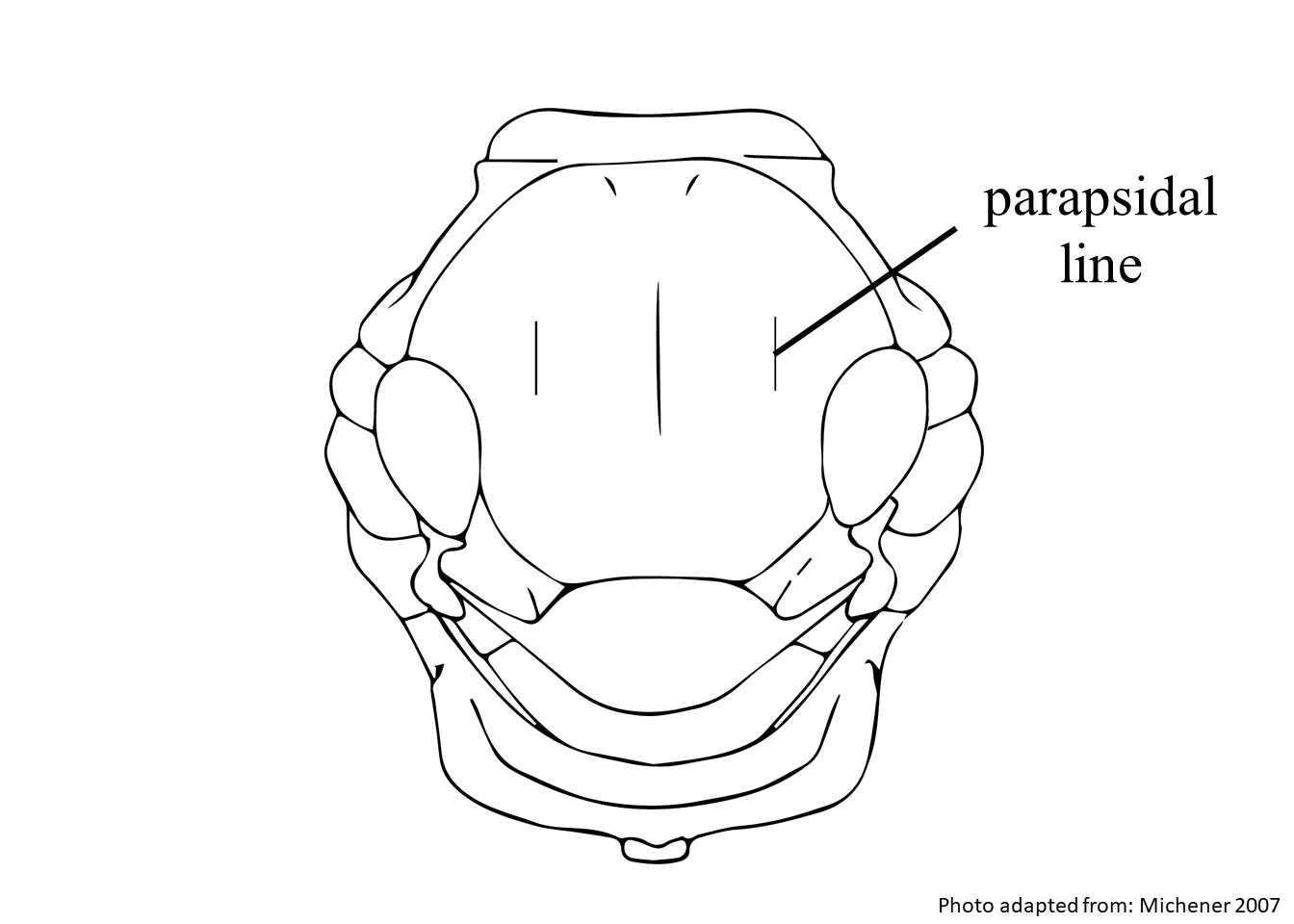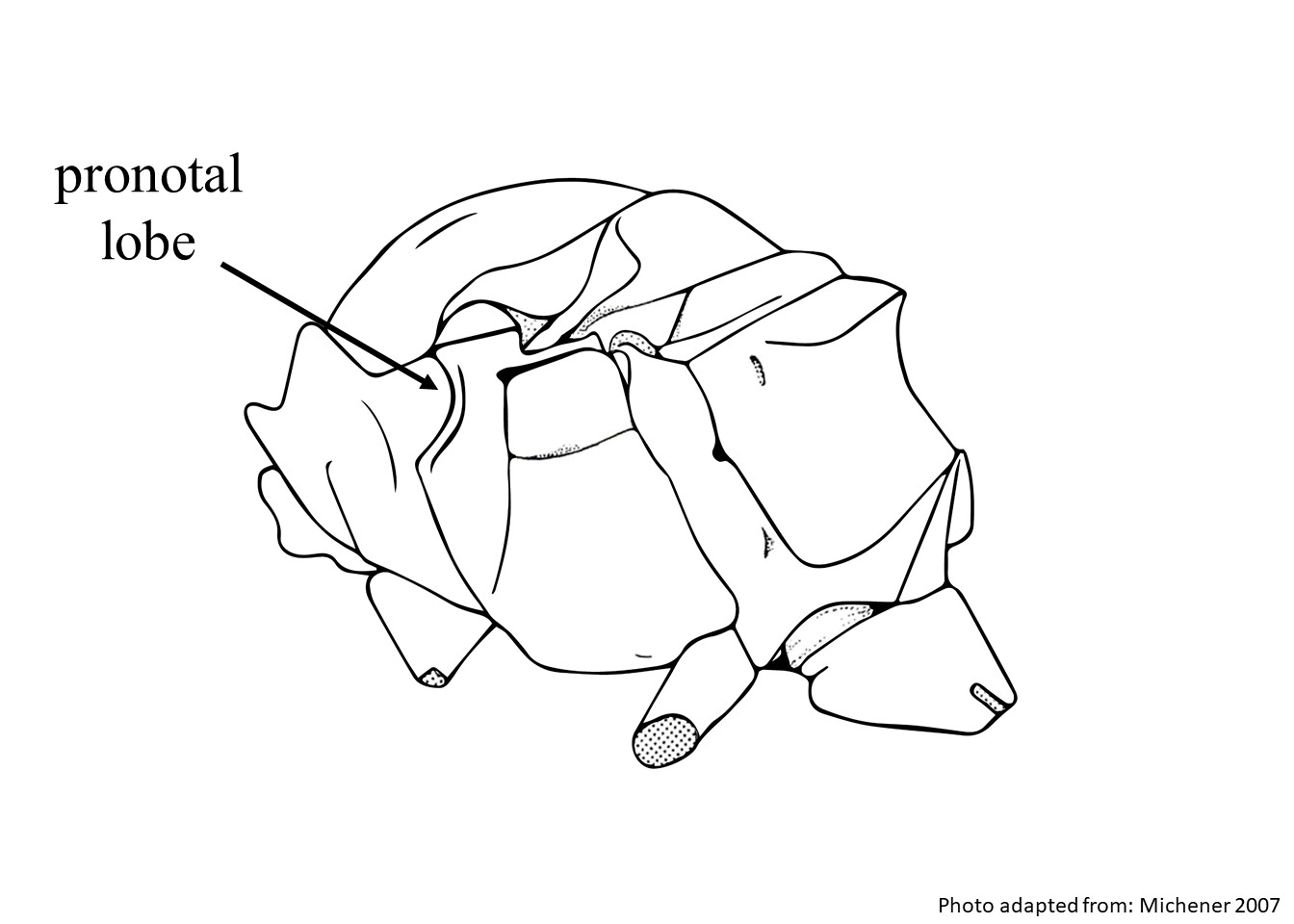Taxonomy
Family: Megachilidae
Subfamily: Megachilinae
Tribe: Aspidosmiini
Genus: Aspidosmia Brauns, 1926
Subgenera: none
Common name: none
Overview
Aspidosmia are dark, non-metallic, robust bees with long hair throughout their bodies and without apicalapical:
near or at the apex or end of any structure
fasciae on their tergaterga:
the segments on the top side of the abdomen, often abbreviated when referring to a specific segment to T1, T2, T3, T4, T5, T6, or T7
 . They range in body length from 8–10 mm (Michener 2007Michener 2007:
. They range in body length from 8–10 mm (Michener 2007Michener 2007:
Michener, C.D. 2007. The Bees of the World (2nd ed.). Johns Hopkins University Press, Baltimore and London, 953 pp.).
Diversity
Aspidosmia contains two species worldwide (
Michener 2007Michener 2007:
Michener, C.D. 2007. The Bees of the World (2nd ed.). Johns Hopkins University Press, Baltimore and London, 953 pp.); none are known to occur in the U.S. or Canada.
Diagnostic characteristics
(modified from Michener 2007Michener 2007:
Michener, C.D. 2007. The Bees of the World (2nd ed.). Johns Hopkins University Press, Baltimore and London, 953 pp. unless otherwise stated)
- Forewing with two submarginal cellssubmarginal cells:
one or more cells of the wing lying immediately behind the marginal cells
 .
.
- Jugal lobe jugal lobe:
the inner most lobe of the hind wing, often set off from the the rest of the wing by a fold and a notch in the margin. The jugal lobe can be absent in some genera.
.jpg) is half as long as the vannal lobevannal lobe:
is half as long as the vannal lobevannal lobe:
often the secondmost inner lobe of the hind wing, usually set off from the the rest of the wing by a fold and a notch in the margin. The jugal lobe can be absent in some genera and in those cases the jugal lobe is the innermost lobe of the hind wing.
.jpg) on the hind wing.
on the hind wing.
- Long-haired, without distinct apicalapical:
near or at the apex or end of any structure
hair bandsbands:
usually referring to bands of hair or bands of color that traverse across an abdominal segment
.
- Middle tibiatibia:
the segment of the leg, between the femur and the tarsus
 with one apicalapical:
with one apicalapical:
near or at the apex or end of any structure
spine or projection.
- Parapsidal line parapsidal line:
the line that runs submedially along the scutum and corresponds to the median border of the site of origin for flight muscles
 linear, at least one-fourth as long as tegulategula:
linear, at least one-fourth as long as tegulategula:
the usually oval, small shield-like structure carried at the extreme base of the wing where it attaches to the body
 (Griswold and Michener 1997Griswold and Michener 1997:
(Griswold and Michener 1997Griswold and Michener 1997:
Griswold, T.L. and C.D. Michener. 1997. The classification of the Osmiini of the Eastern Hemisphere (Hymenoptera, Megachilidae). Journal of the Kansas Entomological Society 70: 207ndash;253).
- Prestigma prestigma:
the expansion of the venation at the confluence of the costal/subcostal and radial sector veins basal of the prostigma
about as long or longer than the stigmastigma:
a pigmented/ thickened spot on the costal margin of the forewing, usually at the end of the radius(Greek, stigma= mark)
 .
.
- Pronotal lobe pronotal lobe:
a part of the pronotum located dorsally on the posterior margin of the pronotum and overlaps the anterior thoracic spiracle
 without carinacarina:
without carinacarina:
a clearly defined ridge or keel, not necessarily high or acute; usually appears on bees as simply a raised line
.
- Second recurrent vein enters the second submarginal cell.
- Female has scopa-like hairs on the hind tibiatibia:
the segment of the leg, between the femur and the tarsus
 .
.
- Male clypeusclypeus:
a section of the face below the antennae, demarcated by the epistomal sutures
 partially yellow, but lack yellow maculations on the rest of the body.
partially yellow, but lack yellow maculations on the rest of the body.
- Male T6T6:
the segments on the top side of the abdomen, often abbreviated when referring to a specific segment to T1, T2, T3, T4, T5, T6, or T7
 apicalapical:
apicalapical:
near or at the apex or end of any structure
margin simple, without preapicalpreapical:
referring to a section of a bee that is physically found just before the outermost (or apical) end of the section or segment
carinacarina:
a clearly defined ridge or keel, not necessarily high or acute; usually appears on bees as simply a raised line
or laterallateral:
relating, pertaining, or attached to the side
teeth (Griswold and Michener 1997Griswold and Michener 1997:
Griswold, T.L. and C.D. Michener. 1997. The classification of the Osmiini of the Eastern Hemisphere (Hymenoptera, Megachilidae). Journal of the Kansas Entomological Society 70: 207ndash;253).
May be confused with
Aspidosmia resembles Plesianthidium due to the lack of yellow markings except on the clypeusclypeus:
a section of the face below the antennae, demarcated by the epistomal sutures
 ; however, this similar feature likely evolved independently and is superficial (Michener 2007Michener 2007:
; however, this similar feature likely evolved independently and is superficial (Michener 2007Michener 2007:
Michener, C.D. 2007. The Bees of the World (2nd ed.). Johns Hopkins University Press, Baltimore and London, 953 pp.).
Aspidosmia males can be differentiated from Plesianthidium because Aspidosmia lacks marginal combs on all sternasterna:
the plates on the underside of the abdomen, often abbreviated when referring to a specific segment to S1, S2, S3, S4, S5, S6, S7, or S8
 and have a bilobed or bidentatebidentate:
and have a bilobed or bidentatebidentate:
having two teeth
T7. Aspidosmia females can be readily distinguished from most Megachilidae genera by the presence of scopa-like hairs on the hind tibiatibia:
the segment of the leg, between the femur and the tarsus
 .
.
Known invasives
There are no known invasives.
Host associations
Host associations are not well known. Aspidosmia arnoldi has been observed visiting Lebeckia sericea (Fabaceae) and Lycium spp. (Solanaceae) (Struck 1994Struck 1994:
Struck, M. 1994. Flowers and their insect visitors in the arid winter rainfall region of southern Africa: observations on permanent plots. Insect visitation behavior. Journal and Arid Environments 28: 51ndash;74.).
Nesting behavior
Nesting behavior is unknown.
Distribution
Aspidosmia occurs in Namibia and Cape Province, South Africa (Michener 2007Michener 2007:
Michener, C.D. 2007. The Bees of the World (2nd ed.). Johns Hopkins University Press, Baltimore and London, 953 pp.).

Distribution map generated by Discover Life -- click on map for details, credits, and terms of use.
References
Griswold, T.L. and C.D. Michener. 1997. The classification of the Osmiini of the Eastern Hemisphere (Hymenoptera, Megachilidae). Journal of the Kansas Entomological Society 70: 207-253
Michener, C.D. 2007. The Bees of the World. 2nd ed. Johns Hopkins University Press, Baltimore and London, 953 pp.
Struck, M. 1994. Flowers and their insect visitors in the arid winter rainfall region of southern Africa: observations on permanent plots. Insect visitation behavior. Journal and Arid Environments 28: 51-74.
 . They range in body length from 8–10 mm (Michener 2007Michener 2007:
. They range in body length from 8–10 mm (Michener 2007Michener 2007:.jpg) is half as long as the vannal lobevannal lobe:
is half as long as the vannal lobevannal lobe:.jpg) on the hind wing.
on the hind wing. .
. apicalapical:
apicalapical:; however, this similar feature likely evolved independently and is superficial (Michener 2007Michener 2007:
 and have a bilobed or bidentatebidentate:
and have a bilobed or bidentatebidentate:.